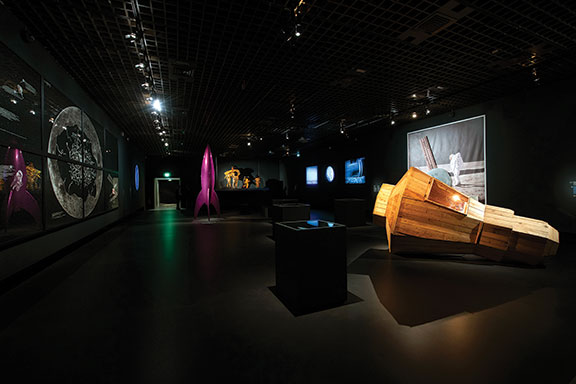« Features
KETTLE’S WHISTLE. Andy, did you hear about this one?
By Michele Robecchi
About two years ago, an extraordinarily fortuitous circumstance occurred. Unbeknownst to one another, in the boardrooms of several art institutions scattered around the globe, staffers were having the same conversation at the same time. Whether initiated by people at the helm, team members or trustees interested enough to participate, it pretty much revolved around this basic question: Why don’t we make an exhibition in 2019 to mark the 50th anniversary of the moon landing?
In what can only be too appropriately described as a cosmic convergence, the responses were equally synchronized. The concept’s selling points—that it would be time-sensitive, of broad interest and likely to reactivate the historical link between art and science—were reviewed with growing appreciation, and curatorial and publicity departments enthusiastically went to work on what had all the elements of being a safe box-office fest.
Cut to a few months later, and the party got started. Undoubtedly facilitated by the flexibility that characterize private organizations, the Aga Kahn Museum in Toronto hit the ground running with “The Moon: A Voyage through Time” (March 9). This was followed by the rather essentially titled “The Moon” at Grand Palais, Paris (April 3); “Moonlight” at the Hasselblad Foundation, Goteborg, Sweden (May 25); and “The Moon Museum 1969″ at the Vasarely Museum, Budapest, Hungary (May 27). The honor of ferrying the concept to the summer season was given to the Fotomuseum in Antwerp, Belgium, which inaugurated—you guessed it—”Photographing the Moon” on June 28, shadowed by “Apollo’s Muse: The Moon in the Age of Photography” at the Metropolitan Museum in New York (July 3); “Ticket to the Moon” at the Kunsthalle Krems, Germany (July 14); and “By the Light of Silvery Moon: A Century of Lunar Photographs” at the National Gallery of Art, Washington, D.C. (July 14).

View from the exhibition “The Moon,” Grand Palais. Scenography: bGc studio agency. © Rmn Grand Palais 2019. Photo: Didier Plowy.
July 20, however, was the exact date Neil Armstrong touched lunar soil, and as such when the highest concentration of events was planned. And so enter “Fly Me to the Moon” at the Salzburg Museum of Modern Art (Germany, July 19); “The Moon” at the Royal Greenwich Museum in London (July 19, no connection with the Paris show); and the Jules Verne-inspired “From the Earth to the Moon: Art traveling towards the Silver Asteroid” at Palazzo Madama in Turin, Italy, (July 19).
With the arrival of fall, doubts about the originality of the idea as well as suspicions that the exercise was becoming a bit tedious began to materialize. This partially accounts for “Milky Way Traffic Regulations (Space is the Place)” at Kunstlerhaus Bethanien in Berlin (Aug. 2)—a tangible curatorial effort to stray from the pack both in terms of presentation and content, cue the somewhat trite but infallible Sun Ra’s reference in the subtitle; or “Moving to Mars” at the Design Museum in London (Oct. 18), where organizers suggested the interesting notion of using moon celebrations as a subtext to address the new big event—the race to Mars. To restore the balance and bring everything back to more conventional lines, the Centre Pompidou in Malaga, Spain, closed the festivities with the environmentally-friendly “The Moon: An Imaginary Space to Defend” (Oct. 18). One of the biggest casualties in all this was the Hayward Gallery in London, which could only watch and bite their nails, having realized the golden opportunity they wasted by making their move way too soon. “Deceitful Moon” opened 10 years ago in the modest setting of the project room—a sign of how little the venerable British institution, which once claimed to aspire to be “the Ikea of Art”—regarded the idea at the time. Be forewarned though: 2020 is the 75th anniversary of the United Nations, the 400th of the trip of the Mayflower, or, to stay true to the theme, Buzz Aldrin’s 90th birthday, in case you wish to gamble on what might be in store.
Far from being a critique of curatorial lack of imagination, it is quite fascinating to see how many permutations of the same concept the human brain can come up with. The exhibitions outlined above are just a small but significant representation of a much larger number, and all feature an incredible number of artists and works. It is just a pity that none of them thought of including Nanni Valentini’s seminal piece 28 Days of the Moon (1980). This is a very poetic and powerful sculpture, at onceemphasizing the intimate yet mysterious relationship our planet entertains with its only satellite. It is also made of clay—a primary and very untechnological material that stresses how the existence of some phenomena goes way further back than the modern understanding of them.
Michele Robecchi is a curator and writer based in London, where he is a Commissioning Editor for Contemporary Art at Phaidon Press. Some of his recent publications include monographs on the work of Sharon Hayes, Yayoi Kusama, Adam Pendleton and Adrián Villar Rojas. He was one of the curators of the 1st and 2nd Tirana Biennale.



































Leave a Reply
You must be logged in to post a comment.